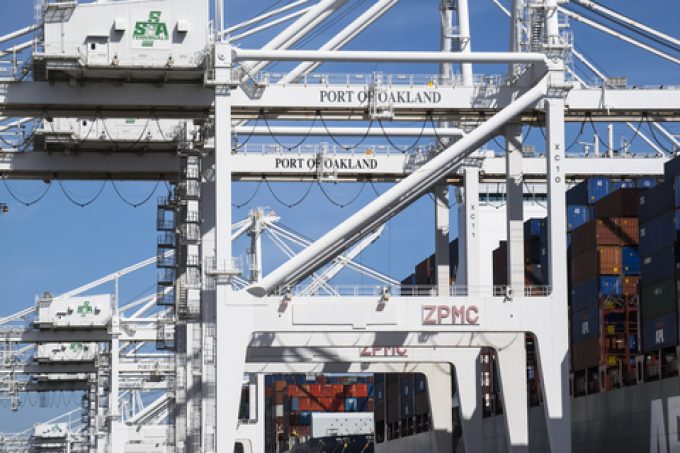US port operators brace for tariff blitz if Trump gets second term
US port operators will be focused on the results of tomorrow’s elections, concerned that potential ...
MAERSK: TRUMP TRADEKNIN: THE SLIDELINE: DEBUT AAPL: ASIA CAPEXDHL: THE HANGOVERXPO: ELECTION DAY RALLY BA: STRIKE OVER GXO: SHEIN AND TEMU IMPACT GXO: PAYING DOWN DEBT AND ORGANIC GROWTH GXO: WINCANTON REGULATORY RISK GXO: PEAK SEASON GXO: WINCANTON STILL A DRAG GXO: FREE CASH FLOW CONVERSION GXO: RETAIL VS INDUSTRIAL TRENDSGXO: WINCANTON UPDATEGXO: CORNERSTONE DEAL SIGNED IN EUROPE GXO: STELLAR THIRD QUARTER GXO: CONF CALL ON THE WAYDSV: DHL READ-ACROSS IN FORWARDING
MAERSK: TRUMP TRADEKNIN: THE SLIDELINE: DEBUT AAPL: ASIA CAPEXDHL: THE HANGOVERXPO: ELECTION DAY RALLY BA: STRIKE OVER GXO: SHEIN AND TEMU IMPACT GXO: PAYING DOWN DEBT AND ORGANIC GROWTH GXO: WINCANTON REGULATORY RISK GXO: PEAK SEASON GXO: WINCANTON STILL A DRAG GXO: FREE CASH FLOW CONVERSION GXO: RETAIL VS INDUSTRIAL TRENDSGXO: WINCANTON UPDATEGXO: CORNERSTONE DEAL SIGNED IN EUROPE GXO: STELLAR THIRD QUARTER GXO: CONF CALL ON THE WAYDSV: DHL READ-ACROSS IN FORWARDING

US container ports with outstanding orders for Chinese-made ship-to-shore cranes are facing a cumulative additional bill of $131m, due to a recent government decision to apply a 25% tariff on the products.
In a submission to the Office of the US Trade Representative (USTR), the American Association of Port Authorities (AAPA) claimed some 35 cranes were under construction in China that would be delivered to US ports after the tariff implementation date of 1 August.
“Assuming an average of $15m per crane (AAPA’s understanding from our membership), the new tariff would mean an additional $131.25m in unexpected costs, before factoring in planned purchases over the next five or 10 years,” says the submission.
By way of example, it cited the east coast port of Virginia, which ordered 12 STS cranes in China, worth $161.52m, an order signed before the tariff announcement.
AAPA said: “Should the tariffs come into effect, the port would be responsible for an additional $40.38m cost.”
And New Orleans, which is developing its Louisiana International Terminal in conjunction with MSC, expects to order an initial 10 units which it believes will now cost an extra $52m.
AAPA added that a recent survey of its members suggested at least another 61 cranes were expected to be ordered in the next five years to cater for expansion plans, and the tariffs could distort competition.
It said: “For the many ports considering crane purchases but have not yet signed contracts, they now have new information they can factor into procurement decisions, allowing them to source STS cranes from other suppliers, shift funding from other projects, or delay acquisition.
“The ports that have already signed contracts are forced to simply absorb millions of dollars in new costs, which may require them to reduce the scope of other projects, take on debt, or delay necessary infrastructure upgrades.”
It called on the USTR to take two actions to prevent these problems.
“First, USTR should delay the effective date for the STS crane tariffs by at least two years, or ideally until there is a US manufacturer capable of providing the product domestically. This would serve the dual purpose of providing relief to ports that have already signed contracts and incentivising domestic production.
“Second, USTR should exclude STS crane purchases from the tariff for those ports that signed contracts to procure cranes prior to the publication of the new tariffs. This would put all ports purchasing STS cranes on a level playing field.”
The crux of the problem for US terminal operators is the lack of domestic container equipment handling manufacturers, and AAPA argued that this would take years, even with an announced $20bn government package to spur investment into the industry.
“It is unlikely that any manufacturers could produce American-made STS cranes with the necessary reliability, durability and specifications to support our seaports within the next several years, even though there is an eventual pathway,” the AAPA added.
Comment on this article